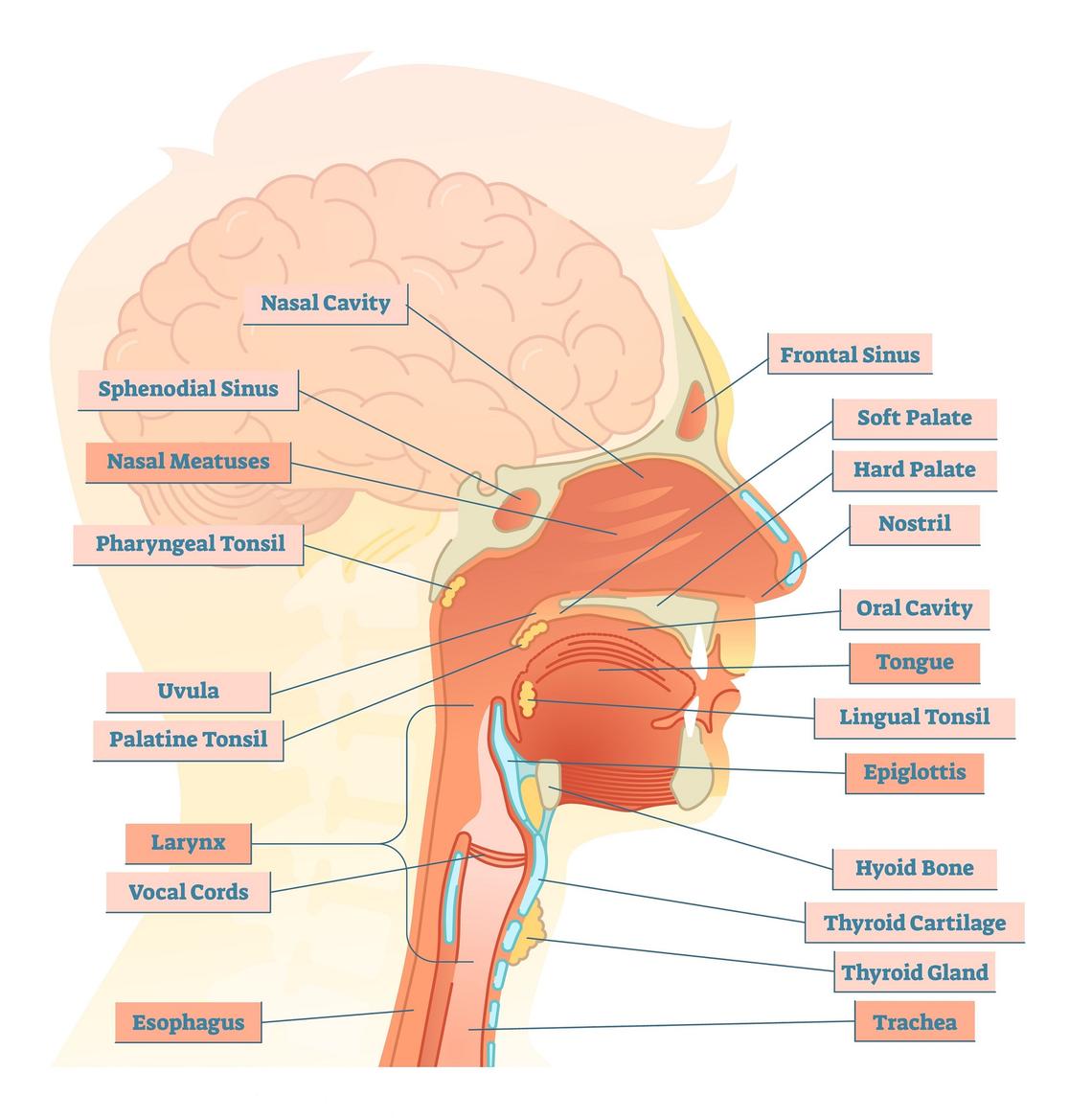Symptoms and Signs
The following is a list of concerning symptoms and signs of head and neck cancer. A patient may have any combination of these findings, and if they persist for more than four-six weeks, the patient should seek medical attention.


Head and neck cancers are the sixth most common cancer worldwide and affect the areas such as the tongue, jaw, throat, neck, swallowing passage, voice box, thyroid gland, and sinuses. Head and neck cancer treatment can be complex and involve any or all treatments, including surgery, radiation and chemotherapy. Therefore, the team of physicians and surgeons required to provide treatment is large and covers many specialties.
Cancer arises when a cell starts to multiply uncontrollably and has the ability to spread. Also called malignant tumours, cancers can arise from many different tissues in the head and neck, but the vast majority develop from the lining of the mouth, throat, breathing tube, and swallowing tube and are called squamous cell carcinomas (SCC). The most common locations for head and neck cancers include the tongue, cheek lining, throat and voicebox.
Cancers can invade adjacent tissues causing destruction and pain. This invasion can cause bleeding, swelling, difficulties with speech and swallowing or a change in voice. Risks for developing SCC include smoking, drinking alcohol, chewing betel nuts, and infection with certain strains of the human papillomavirus (HPV). Other types of head and neck cancer include salivary gland tumours, sarcomas, thyroid cancers, and skin cancers.
The following is a list of concerning symptoms and signs of head and neck cancer. A patient may have any combination of these findings, and if they persist for more than four-six weeks, the patient should seek medical attention.
Red/white patch in mouth
Ulceration/swelling in mouth or on face
Neck mass
Facial weakness/numbness
Hearing Loss
The Head and Neck Surgical Oncology Program at the University of Calgary has developed a clinical care pathway for patients about to undergo major surgery to remove a cancer from the head and neck, with reconstruction using a free flap from elsewhere in the body. This pathway outlines the number of checkpoints and milestones that the patient is expected to meet each day after their major surgery. As the pathway demonstrates, a patient's length of stay in hospital after a surgery of this nature is expected to be approximately ten days.
If cancer is identified early, it can successfully be treated and cured. Treatment can include surgery, radiation therapy and chemotherapy. Some patients may receive only one type of treatment, while some advanced cancers may require all three types. Patients and their families are central in making these treatment decisions. Often discussions will include several specialists. Patients will always have the opportunity to ask questions and may decline treatment at any stage. In advanced cases, a cure may not be possible, and treatment may focus on alleviating pain and improving quality of life.
A biopsy is the process of obtaining a small portion of tissue so that a pathologist can analyze it. In order to make a diagnosis of cancer, a pathologist must examine a small portion of the cancer under a microscope. Once the exact type of cancer is known, a treatment plan can be made.
When cancer is treated surgically, the goal is to remove the entire cancer. This usually involves removing the cancer with a small rim of normal tissue. This can include removing portions of the mouth, throat, sinuses, swallowing tube, and voice box. A neck dissection is often performed at the same time as the cancer resection. This involves removing the lymph nodes in the neck.
When patients have major surgery in the mouth and neck, there is significant swelling for a few weeks, which prevents the patient from breathing through the mouth. For this reason, patients will often undergo a tracheotomy at the same time as the removal of the tumour and the neck dissection. This involves surgically inserting a tube through the neck skin directly into the windpipe, or trachea, so that the patient can breathe without the air having to travel through the mouth and throat. Because air can no longer travel through the mouth, patients are not initially able to talk while the tracheostomy is in place. Frequently, the tracheotomy will be removed about seven days after surgery, allowing the patient to breathe and speak as they normally would through the mouth and nose.
Once the cancer is surgically removed, there may be a need for reconstructive surgery. This can involve filling the cavity that has been created as part of the cancer removal. Alternatively, reconstruction of the jaw bone or tongue may be required, depending on the amount and type of tissue removed. Reconstruction typically involves taking tissue from one part of the body to rebuild the structure in the head and neck.
Common places to take tissue include the forearm, thigh and fibula bone from the leg. Other sites include the abdomen and back. These tissues, called flaps, are taken with an artery and vein to bring oxygen and nutrients to the area and allow it to heal quickly. The artery and vein are connected to vessels in the neck using a microscope.
The sites that these flaps are taken from often require coverage with a skin graft, a thin shaving of skin typically taken from the thigh. The site that the skin graft is harvested from heals over on its own in two weeks.
If the upper or lower jaw requires reconstruction with bone, it may be possible to have dental implants placed. These implants may be funded by Alberta Health, but they require a waiting period of two years after surgery to qualify.
All surgeries are associated with some risks, and these risks increase with the length and complexity of the surgery. They also increase with the age and medical fitness of the patient. Risks may include pneumonia, infections of the wound, wound breakdown, and loss of a portion or all of the flap. Rare and lethal complications can occur.
Sacrifice of sensory nerves of the head and neck may be required to successfully remove the cancer. This leads to numbness in those areas supplied by the nerve. Injury to nerves controlling shoulder or tongue function can occur rarely.
At the surgical site, collections of fluid are infrequent. Occasionally, skin grafts can break down. Numbness of the skin around the flap donor site is common, while loss of motor power at these sites is extremely rare. Pain and swelling at the site of cancer removal and a site used for flap harvest are common and may persist for two to three months.
Most patients will spend one night in the ICU, located in the McCaig Tower adjacent to the Foothills Medical Centre. After the ICU, patients are transferred to Unit 31, located on the third floor of the Foothills Medical Centre. Patients usually spend 9-13 days in the hospital. Initially, patients may have many drains, tubes, and catheters, most of which can be removed one day at a time as the patient’s health and abilities improve. At the University of Calgary, we have developed a standardized process to coordinate all of the many steps that occur during recovery.
Once patients are discharged, a member of the surgical team sees them in approximately two weeks. Patients are encouraged to attend physiotherapy to aid in the return of neck mobility and softening of scars.
Radiation treatment can be used by itself to treat some head and neck cancers or in combination with surgery to treat more advanced head and neck cancers.
Radiation therapy involves delivering a beam of high-energy x-rays to the location of the cancer and any areas close to the cancer that may be at risk of cancer spread. These x-rays can destroy the cancer cells. Careful treatment planning allows for the surrounding normal tissues to not be damaged by the x-rays.
Treatment of head and neck cancer with radiation usually involves approximately 30 treatments every day for six to seven weeks (not including weekends). A small amount of x-ray treatment is given each day until the total dose has been delivered.
Early side effects of radiation include skin changes similar to sunburn, sores in the mouth and throat, a sore throat and difficulty swallowing, swelling of the neck, and dryness in the mouth. These early side effects usually improve within 6-12 weeks after the completion of radiation treatment.
Chemotherapy is a medicine given in pill form or through an intravenous line and is designed to destroy any cancer cells in the body. Studies have shown that giving chemotherapy at the same time as radiation can improve the chances of eliminating head and neck cancer when the cancer is more advanced. Drugs that are most frequently given include cisplatin, fluorouracil, and cetuximab.
There are several possible side effects of chemotherapy: nausea, loss of appetite, fatigue, kidney damage, and damage to hearing. For this reason, the decision to take chemotherapy must be made carefully and may not be suitable for all patients.